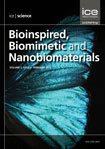
Bioinspired Biomimetic and Nanobiomaterials
Scope & Guideline
Harnessing Nature's Wisdom for Advanced Biomaterials
Introduction
Aims and Scopes
- Biomimetic Material Development:
The journal emphasizes the design and synthesis of materials that mimic natural structures and functions, enhancing their performance in applications such as drug delivery, bone grafting, and tissue engineering. - Nanotechnology in Biomedicine:
A core focus is on the utilization of nanomaterials and nanotechnology to improve medical applications, including drug delivery systems, antibacterial agents, and imaging techniques. - Innovative Biomedical Applications:
The journal seeks to publish research that explores new biomedical applications of bioinspired materials, including their effects on cell behavior, tissue regeneration, and overall biocompatibility. - Interdisciplinary Research:
The journal encourages interdisciplinary collaboration, bringing together insights from biology, chemistry, materials science, and engineering to foster the development of novel biomimetic solutions. - Sustainability and Green Chemistry:
Research that highlights sustainable practices in the synthesis of biomimetic materials and the use of environmentally friendly methods is a significant theme, contributing to the field's growth towards greener technologies.
Trending and Emerging
- Nanoparticle Therapy and Drug Delivery:
Recent publications increasingly explore the use of nanoparticles for targeted drug delivery, particularly against antibiotic-resistant bacteria, highlighting the critical need for novel therapeutic strategies. - Bioactive and Biocompatible Materials:
There is a growing interest in the development of bioactive materials, such as ion-doped bioactive glasses and hydroxyapatite composites, which are crucial for enhancing osteogenic activity and tissue integration. - Microbial and Biogenic Synthesis:
Emerging studies focus on biogenic approaches for synthesizing nanomaterials, leveraging natural processes to produce environmentally friendly and effective materials for biomedical applications. - Smart and Responsive Materials:
The journal is witnessing an increase in research on smart materials that respond to environmental stimuli, offering potential advancements in drug delivery and tissue engineering. - Advanced Characterization Techniques:
Recent works emphasize sophisticated characterization methods to assess the structure and properties of biomimetic materials, underscoring the importance of thorough material analysis in research.
Declining or Waning
- Traditional Biomaterials:
Research related to conventional biomaterials without innovative biomimetic approaches seems to be less frequently published, as the journal shifts towards more advanced, nature-inspired materials. - Basic Bioactivity Studies:
Papers focusing solely on basic bioactivity without the integration of nanotechnology or biomimetic principles are declining, indicating a preference for studies that combine multiple innovative aspects. - Non-Biomedical Applications:
There is a notable reduction in topics related to non-biomedical applications of biomimetic materials, such as industrial uses, suggesting a more concentrated focus on medical and health-related applications.
Similar Journals

Materials Today Bio
Unlocking innovative solutions at the intersection of materials and biology.Materials Today Bio, published by Elsevier, is an esteemed open-access journal dedicated to advancing the fields of bioengineering, biomaterials, and biomedical engineering. Since its inception in 2019, this journal has quickly made a name for itself, currently ranked Q1 in multiple categories including Bioengineering, Biomaterials, and Biotechnology, reflecting its exceptional quality and relevance in the rapidly evolving landscape of bio-related sciences. With an impressive Scopus ranking positioning it in the top 25% of its categories, Materials Today Bio provides a vital platform for researchers and professionals to share cutting-edge discoveries and innovative applications that bridge the gap between materials science and biological studies. Accessible to a global audience, this journal not only fosters collaboration among the scientific community but also aims to highlight significant advancements in cell and molecular biology, making it an indispensable resource for students and seasoned experts alike. The journal's commitment to open access since 2019 underscores its dedication to disseminating knowledge widely, ensuring that crucial findings reach those who can benefit from them the most.

Journal of Materials Chemistry B
Advancing the Frontiers of Materials Chemistry.Journal of Materials Chemistry B is a prestigious peer-reviewed journal published by the Royal Society of Chemistry, specializing in the latest advancements in the realm of materials chemistry. With a profound impact in the scientific community, this journal has achieved impressive Q1 quartile rankings in 2023 across several categories, including Biomedical Engineering, Miscellaneous Chemistry, Materials Science, and Medicine, illustrating its pivotal role in interdisciplinary research. Its impressive Scopus rankings further emphasize its widespread recognition, with notable placements in the top percentiles for various fields. Covering a broad scope of topics from novel materials for biomedical applications to innovative chemical synthesis techniques, the journal aims to promote knowledge exchange and foster collaborative research across disciplines. Although not an open-access journal, it offers a platform for researchers to share their findings and contribute to the evolving discourse within materials science. With a publication record spanning from 2013 to 2024, the Journal of Materials Chemistry B remains an essential resource for researchers, professionals, and students dedicated to exploring the frontiers of materials chemistry.

Functional Materials
Exploring the Future of Materials Science.Functional Materials is a pioneering journal dedicated to the exploration and application of innovative materials science. Published by the NATL ACAD SCIENCES UKRAINE, INST SINGLE CRYSTALS, this journal provides a platform for researchers, professionals, and students to disseminate their findings in the realm of functional materials, which play a crucial role in various technological advancements. With an ISSN of 1027-5495 and E-ISSN 2218-2993, Functional Materials features research articles that span the spectrum of material properties and behaviors, contributing to both theoretical and applied sciences. Despite its current categorization in the Q4 quartile of Materials Science (miscellaneous) as of 2023, the journal aspires to foster impactful research, encouraging submissions that push the boundaries of knowledge and innovation in the field. Located in Kharkiv, Ukraine, the journal is an integral resource for anyone involved in materials science, providing insights that drive future discoveries and applications.

JOURNAL OF BIOMEDICAL MATERIALS RESEARCH PART B-APPLIED BIOMATERIALS
Connecting Material Science and Medicine for a Healthier FutureJOURNAL OF BIOMEDICAL MATERIALS RESEARCH PART B-APPLIED BIOMATERIALS, published by Wiley, is a leading journal in the field of biomaterials and biomedical engineering, with an impact factor reflected in its relevant Scopus rankings—including a Q2 position in Biomedical Engineering and Q3 in Biomaterials for 2023. This journal, with ISSN 1552-4973 and E-ISSN 1552-4981, serves as a vital platform for disseminating pioneering research and innovative applications of biomaterials. Positioned in the United States, it aims to bridge the gap between material science and biological applications, fostering collaboration among researchers, professionals, and students dedicated to advancing technology in healthcare. With a convergence of studies from 2003 to 2024 and a growing focus on open access, the journal ensures greater visibility and accessibility for groundbreaking research. Join us in exploring the dynamic field of biomaterials, as we push the boundaries of science and engineering for improved patient outcomes.

Regenerative Biomaterials
Bridging Science and Application in BiomaterialsRegenerative Biomaterials, published by Oxford University Press, serves as a premier platform for the dissemination of innovative research in the rapidly evolving field of biomaterials. Since its inception in 2014, this esteemed open-access journal has fostered a collaborative and diverse scientific community, providing free access to impactful articles that enhance our understanding of regenerative medicine and tissue engineering. With a commendable impact factor and ranking within the top quartiles of both Biomedical Engineering and Materials Science, it is recognized for its rigorous peer-review process and high-quality publications. The journal aims to bridge the gap between fundamental research and applied sciences, promoting advanced studies that contribute to clinical applications and regeneration strategies. Researchers, practitioners, and students alike are encouraged to engage with the journal’s content to foster interdisciplinary collaboration and drive future innovations in the biomaterials domain.

JOURNAL OF NANOBIOTECHNOLOGY
Elevating Research in Nanobiotechnology to New HeightsJOURNAL OF NANOBIOTECHNOLOGY is a distinguished academic journal published by BMC in the field of nanobiotechnology, focusing on the intersection of nanoscience, biotechnology, and biomedical engineering. Since its inception in 2003, this open-access journal has played a pivotal role in disseminating high-quality research, becoming a leading platform for innovators and scholars alike. With a remarkable impact factor and consistently ranking in the Q1 category across multiple fields—including Applied Microbiology, Bioengineering, and Pharmaceutical Science—the journal demonstrates its critical relevance and influence in advancing knowledge and applications in nanobiotechnology. Furthermore, its impressive Scopus rankings reflect its commitment to rigorously peer-reviewed content, making it a go-to resource for researchers, professionals, and students striving to push the boundaries of science. Given its broad scope, covering emerging trends and technologies, JOURNAL OF NANOBIOTECHNOLOGY continues to foster collaboration and innovation across multidisciplinary fields, inviting submissions from across the globe.

International Journal of Nanomedicine
Empowering researchers to redefine the landscape of medicine.International Journal of Nanomedicine, published by DOVE MEDICAL PRESS LTD, is a leading open access journal dedicated to advancing the field of nanomedicine and its applications in healthcare. Since its establishment in 2006, the journal has grown significantly, now encompassing a wide array of topics including bioengineering, biomaterials, biophysics, drug discovery, and pharmaceutical sciences, and is recognized in Q1 quartiles across major categories like *Nanoscience and Nanotechnology* and *Organic Chemistry*. The journal boasts an impressive standing within the Scopus rankings, with high percentiles across various related fields, making it an invaluable resource for researchers, professionals, and students seeking to stay informed on the latest innovations and developments in nanomedicine. With its commitment to fostering an accessible and collaborative academic environment, the International Journal of Nanomedicine serves as a vital platform for disseminating transformative research that impacts scientific practice and healthcare outcomes globally.

Progress in Biomaterials
Empowering Interdisciplinary Collaboration in BiomaterialsProgress in Biomaterials is a premier journal published by Springer Heidelberg, dedicated to advancing the field of biomaterials through the dissemination of high-quality research articles, reviews, and case studies. The journal, with an ISSN of 2194-0509 and an E-ISSN of 2194-0517, holds an esteemed position within both the Biomaterials and Chemical Engineering fields, as evidenced by its rankings in the Q2 and Q1 quartiles, respectively. With its convergence over the years from 2013 to 2023, it has maintained a strong impact on scientific discourse, ranking #15 in Chemical Engineering and #30 in Biomaterials according to Scopus metrics. The journal is based in Heidelberg, Germany, and aims to provide an open platform for interdisciplinary collaboration amongst researchers, professionals, and students alike, fostering innovation and progress in biomaterials research. As a crucial resource for those engaged in this dynamic field, it empowers authors and readers to explore the latest trends, technologies, and applications in biomaterials development.

Biomedical Materials
Exploring the Intersection of Biology and Engineering.Biomedical Materials, published by IOP Publishing Ltd, is a premier journal dedicated to the rapidly evolving field of biomedical engineering and materials science. With a robust impact factor showcasing its influence, this journal serves as a vital platform for disseminating pioneering research from 2006 to 2024. Covering an array of interdisciplinary topics—ranging from biomaterials to bioengineering and applied chemistry—the journal consistently ranks in the second quartile across multiple categories including Bioengineering (Q2), Biomaterials (Q2), and Biomedical Engineering (Q2) as of 2023. Researchers, professionals, and students alike benefit from its contributions, exploring innovative solutions at the intersection of biology and material science. Although not an Open Access journal, Biomedical Materials remains essential in advancing our understanding and facilitating discussions surrounding state-of-the-art materials that revolutionize medical applications and enhance patient care.

Journal of Biomimetics Biomaterials and Biomedical Engineering
Innovating Healthcare through Nature-Inspired DesignThe Journal of Biomimetics Biomaterials and Biomedical Engineering, published by TRANS TECH PUBLICATIONS LTD, stands at the forefront of interdisciplinary research that merges biology with engineering to address real-world challenges in healthcare and material science. Since its inception in 2014, the journal has contributed valuable insights into the development of innovative biomaterials and biomedical applications, showcasing research excellence in its fields, including biotechnology and bioengineering. With an ISSN of 2296-9837 and an E-ISSN of 2296-9845, this journal provides a platform for both emerging and established researchers to disseminate their work, fostering knowledge transfer across the global scientific community. Currently positioned in the Q4 quartile across categories such as Bioengineering, Biomedical Engineering, and Biotechnology, it aims to enhance its impact through open-access policies and rigorous peer-review processes. With its headquarters in Germany, the journal welcomes diverse contributions from around the world, shaping the future of biomimetic technologies and advancing our understanding of complex biomedical systems.